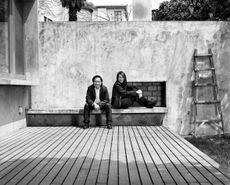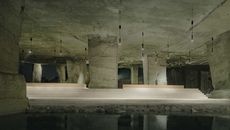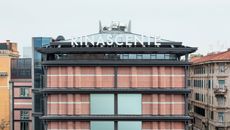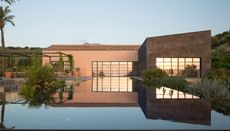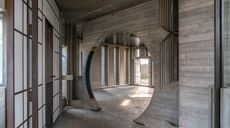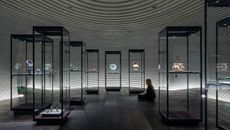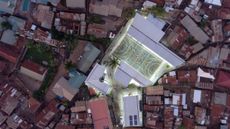Piuarch's innovative urban gardening kit
Milan studio Piuarch moves from green roofs to a multipurpose module for city dwellers, offering planting, workstation and wellness space in one
- (opens in new tab)
- (opens in new tab)
- (opens in new tab)
- Sign up to our newsletter Newsletter
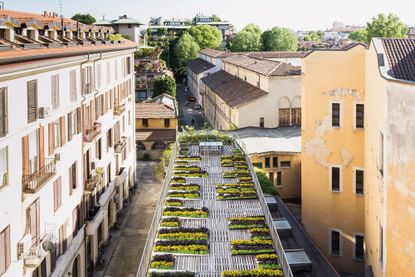
Milan has long been a city of secret gardens. In this dense, industrial, grande dame of a metropolis, composed of large apartment blocks and walled-off palazzos, one of the great joys of wandering aimlessly is accidentally discovering the planted clearings and courtyards that offer respite from its fabricated scenery. Still, many such green spots remained private and off-limits to most until recently, when more parks and community vegetable gardens slowly started to make an appearance. Milan Green Week in 2019 and local organisations such as Clever Cities and RoofMatters have been helping to foster sustainable practices in the city, including a culture of urban gardening and green roofs.
Brera-based architecture studio Piuarch has been cultivating its own planted roof since 2015, titled Garden Among the Courtyards – enhancing liveability, wellbeing and social relations for both employees and the local neighbourhood. Directors Germán Fuenmayor, Gino Garbellini, Monica Tricario and Francesco Fresa believe that while the design community is aware and engaged in the dialogue about creating more green space in their city, there’s still much to do. ‘It is not only about urban planning but also about subverting social, cultural and educational policies within the city and people,’ says Fresa.
Their Re-Made response? An urban gardener’s survival kit, conceived as a design object that bridges functionality and aesthetics, while providing a muchneeded horticultural solution for city dwellers with no access to green spaces. The aim is to develop ‘a modular totem of urban agriculture for individuals living in cities’, explains Fresa. ‘The module combines multiple functions, becoming a sort of multi-tool, a place to read, work, meditate, listen to music and work out.’

Piuarch has devised a blueprint for urban gardeners that embraces multiple functions. Solar power and a charging pad mingle with planting space in the fold-out module
The practice is no stranger to exploring the environmental and social aspects of architecture. ‘For us, the very concept of sustainability has many different meanings, not only in terms of energy and preserving the environment, but regarding landscape and social elements, too,’ says Fresa. ‘That is why cities have kind of lost their sense of place in their attempt to be smarter than ever. They are losing contact with both the human and the natural dimensions.’
The team has been involved in a variety of projects around urban agriculture and sustainable food production. Examples include the vegetable garden on their own green roof, conceived as an ecosystem that fosters biodiversity, improves the food supply chain and guarantees quality products; Espaço, a 2018 installation in São Paulo, aimed at restoring neglected urban areas and empowering the local community, especially children, involving them in play-training and food gardening activities; and Synergy Gardens, a 2018 network of urban gardens on rooftops of Chicago Public Schools, in the so-called ‘food deserts’, low-income neighbourhoods with limited access to nutritious food. For Piuarch, this Re-Made project is part of a wider discourse about reimagining cities and envisioning a more sustainable future for all.
‘The kit aims at creating a domestic Eden to grow plants and bring nature back into people’s lives, as well as taking care of wellbeing, and fostering healthy and enriching activities in a small place. It’s a sort of cabinet for multiple uses,’ says Fresa. ‘While we all agree on the benefits of open-air activities and consuming healthy organic food, we also know that not everyone living in big cities is able to do that on a daily basis. It can be an issue of time, space, money or the recent pandemic.’
While the project was developed before Covid-19 hit, the Milan-based team’s recent experience of lockdown has given the concept – a product to improve small-space living – new meaning and importance. ‘It can become a powerful tool,’ points out Fresa.
The kit comes as a simple, totem-like piece of furniture, which unfolds into a little garden, complete with hydroponic system and solar panels, a table, seats, telephone charger pad, sound amplifier and yoga mat station. Inspiration came from multifunctional objects that transform to accommodate a range of uses, and even the efficiency of the old-school one-man band. The team are on the hunt for the right manufacturing partner, and they say that options such as recyclable biocomposite plastics or timber, or even renewable, intelligent packaging material, are appealing to explore.
‘Everyone should have a rooftop garden, everyone should be able to enjoy the benefit of urban agriculture,’ concludes Fresa. ‘It is challenging, pleasant and helps to raise awareness of food and ecological choices.’
INFORMATION
piuarch.it (opens in new tab)
Ellie Stathaki is the Architecture Editor at Wallpaper*. She trained as an architect at the Aristotle University of Thessaloniki in Greece and studied architectural history at the Bartlett in London. Now an established journalist, she has been a member of the Wallpaper* team since 2006, visiting buildings across the globe and interviewing leading architects such as Tadao Ando and Rem Koolhaas. Ellie has also taken part in judging panels, moderated events, curated shows and contributed in books, such as The Contemporary House (Thames & Hudson, 2018) and Glenn Sestig Architecture Diary (2020).
-
 2022 fashion highlights, as picked by the Wallpaper* team
2022 fashion highlights, as picked by the Wallpaper* teamThe Wallpaper* fashion and beauty team reflect on their personal 2022 fashion highlights – from Gaetano Pesce at Bottega Veneta and Wales Bonner in Florence to intrigue and seduction at Prada
By Jack Moss • Published
-
 Marre Moerel’s swinging flame candle uses artful balance
Marre Moerel’s swinging flame candle uses artful balanceVita Balanza by Marre Moerel and Santa & Cole has turned candles into a balancing act
By Martha Elliott • Published
-
 At home with Neri & Hu
At home with Neri & HuArchitectural super-pair Neri & Hu talk to us about what inspires them, what they are reading, and how they switch off
By Ellie Stathaki • Published
-
 The Fendi factory in Tuscany disappears into the landscape
The Fendi factory in Tuscany disappears into the landscapeThe new Fendi Factory in Italy, set in the rolling hills of Tuscany, is the brainchild of Milan architecture studio Piuarch and the luxury brand
By Ellie Stathaki • Published
-
 Sustainable architecture: innovative and inspiring building design
Sustainable architecture: innovative and inspiring building designThis is sustainable architecture at its best: from amazing abodes to centres of care and hard-working offices, these buildings not only look good but also do good
By Ellie Stathaki • Published
-
 Step inside the dramatic Cava Arcari by David Chipperfield
Step inside the dramatic Cava Arcari by David ChipperfieldCava Arcari by David Chipperfield reimagines a series of caves outside Vicenza as a multifunctional event space
By Ellie Stathaki • Published
-
 Rinascente is reborn in Rome’s Piazza Fiume courtesy of design studio 2050+
Rinascente is reborn in Rome’s Piazza Fiume courtesy of design studio 2050+Rinascente in Piazza Fiume, Rome gets a makeover by Milan-based interdisciplinary design agency 2050+
By David Plaisant • Published
-
 This Sicilian villa brings contemporary architecture to the foot of Mount Etna
This Sicilian villa brings contemporary architecture to the foot of Mount EtnaL House is a modern Sicilian villa in perfect sync with its surroundings, designed by London-based architecture practice Transit Studio
By Ellie Stathaki • Published
-
 Take the ultimate Carlo Scarpa tour of Venice
Take the ultimate Carlo Scarpa tour of VeniceA Carlo Scarpa tour to end all tours; join our survey of modernist buildings by the Italian midcentury master in and around Venice
By Natasha Levy • Last updated
-
 Etruscan Galleries at Fondazione Luigi Rovati by Mario Cucinella just flow
Etruscan Galleries at Fondazione Luigi Rovati by Mario Cucinella just flowIn Milan, the Etruscan Galleries at the Fondazione Luigi Rovati, designed by architect Mario Cucinella, open to the public
By Ellie Stathaki • Last updated
-
 Kéré Architecture’s Uganda community centre provides safety and opportunity
Kéré Architecture’s Uganda community centre provides safety and opportunityA Uganda community centre created by Kéré Architecture was designed with development in mind
By Martha Elliott • Published


